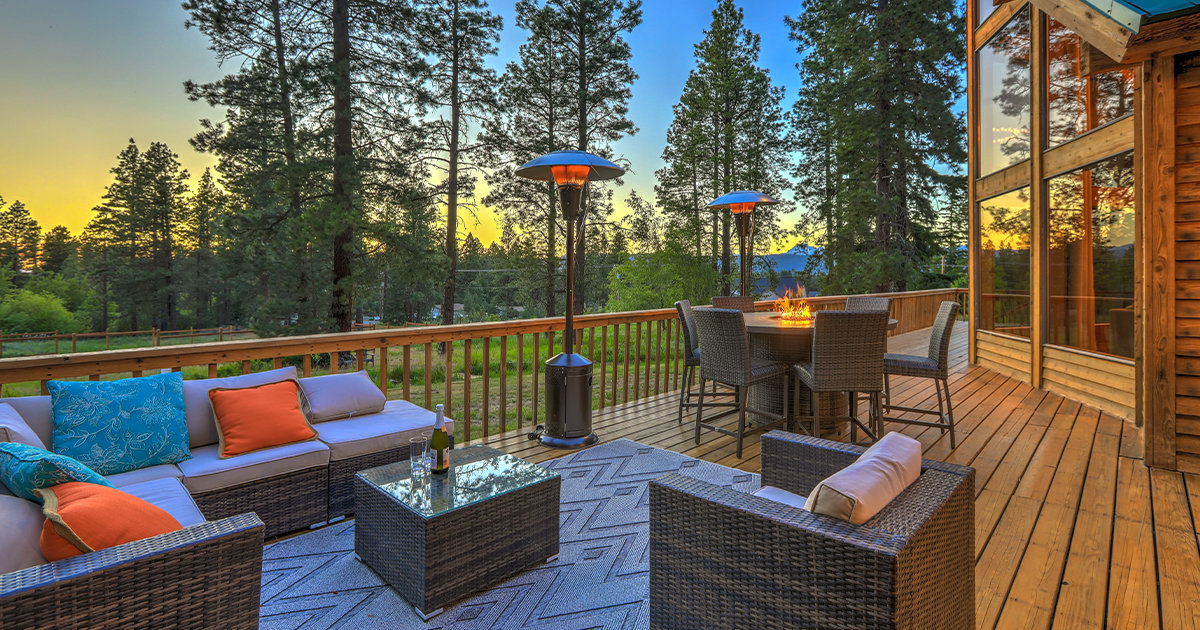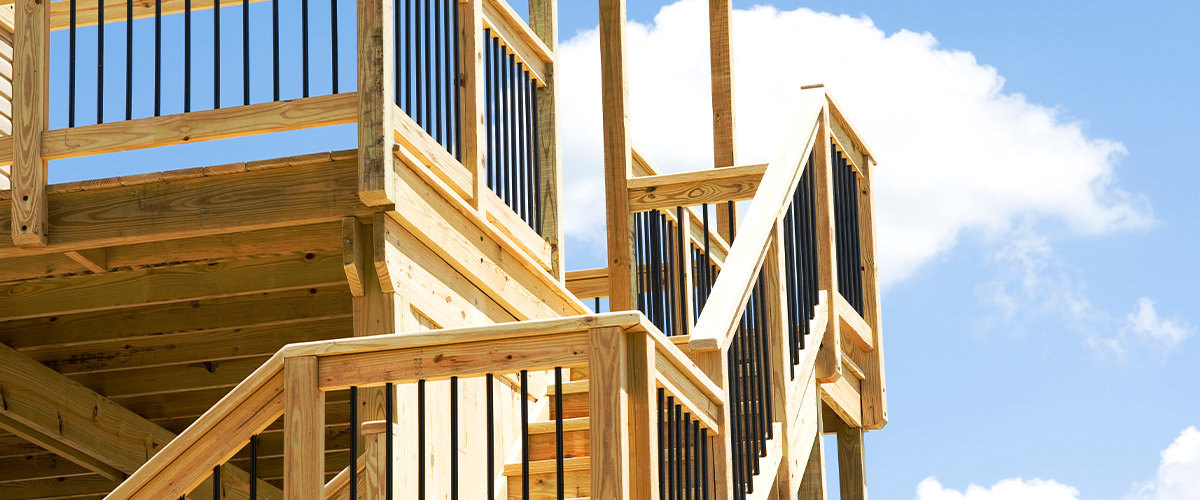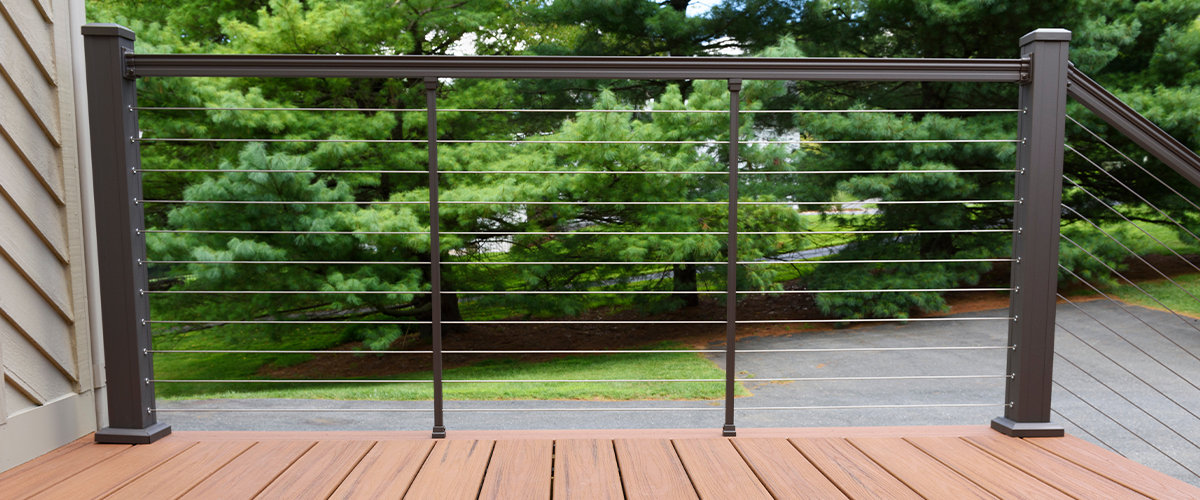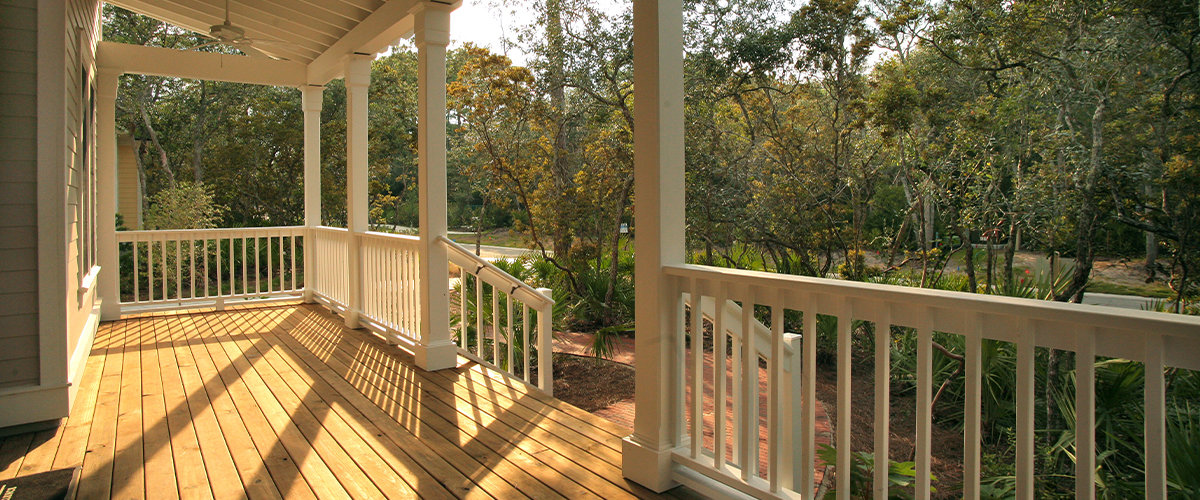
We collect basic website visitor information on this website and store it in cookies. We also utilize Google Analytics to track page view information to assist us in improving our website.
Spring Season starting to book up. Promotions Available for Winter.

If you have room in your backyard, building a sturdy and long-lasting deck only makes sense.
Your custom deck will be the most popular outdoor part of your property. It’s where summer action happens, be it barbecues, parties, gatherings, or quiet nights spent with a glass of wine.
It’s also one of the best investments a property owner can make. It not only gives you the option to entertain friends and families on sunny days and warm nights, but it also adds to the resale value of the house.
It’s an empty platform.
Sometimes people decide against railings because they’ve already spent a bucket-load of money on the deck itself. They may also feel railings are going to take away from the clean-cut look of their newly built deck.
But if you put all that aside for a moment, you’ll realize a deck without a railing is an accident waiting to happen. Railings are required to prevent falls and injuries.
Just as there are rules and regulations around deck building — you need permits and approvals from the municipality — there are also railing codes you need to follow.
Also, think about all the wonderful decorations you can do on the railings come the holiday season.
In Ontario, any platform that is higher than 23¾ inches above finished grade requires some type of railing. At that elevation or higher, a railing height of a minimum of 36 inches is a must, with only 4 inches allowed between the surface and where the railing begins.
In addition, railings are required on all sides of the deck that do not have a wall. Railings are also needed if the ground is 4 feet from the deck slopes at an angle steeper than 30 degrees.
Check with your contractor and municipal staff for the exact building code requirements in your area. They will know if you require a permit to install railings. Or just let the experts at Premier handle this for you. Our team pulls all the permits needed and makes sure your deck is fully up-to-code.
Railings are worth the investment to keep everyone safe, and they add a classy touch and finish to the deck. So, it’s a win-win situation!
The permit part can be taken care of later, but let’s get working on the type of railings you’re going to get.
Just like there are various deck-building materials on the market, there are many types of railings you can choose from.
First, let’s look at the anatomy of a deck railing: it’s made up of rails, posts, and infill.
Rails go horizontally along the top and bottom. The infill slats fill the space between the posts, which falls one on each end. Infill can either be made of balusters or glass panels or metal cables.
The first couple factors to consider are cost and maintenance. The material should also be sturdy and be able to withstand storms.
Then comes fashion. You should select a material that matches your deck. Your choice should also suit the style of your house. If you’ve got a contemporary home perhaps a glass railing would enhance the look of the deck.
If you live in a rustic farmhouse-style dwelling maybe a wood railing would be the best option.
Railings come in all colours and materials, but they’re not all made equal.
Let’s take a closer look at some popular types of railings.
Wood is a classic and age-old material for railings, inside or outside. Nothing matches its look, feel, and grandeur. Where it may be the oldest material used for railings, there are some clear pros and cons for this type of railing.

Let’s look at the positives of using wood railings for your deck or anywhere else in your house.
Wood is a natural material and is malleable for any kind of design. You can go all out and buy customized railings carved with elaborate or simple and classy designs.
Wood gives a very rich look to the property it adorns. This organic substance can be molded to suit any style of house from traditional to contemporary finishes. And its styling doesn’t end just there — you can add distinctive balusters, post caps, or recessed lighting to wood, too. Consider putting metal or glass as infill if you’re interested in a mix and match option.
Lastly, wood can easily be stained any colour of your choice or you can leave it raw for organic appeal. Wood railings complement deck furniture very well because it’s usually made of wood, too.
However, what’s great in some ways can be limiting in other ways.
Even if wood railings are treated, the material is more susceptible to harsh outdoor elements than any of its contemporaries, like vinyl, composite, or metal. Staining the wood can protect it to some extent from nature that batters it constantly, especially since stains these days contain wood-friendly substances that give UV protection, sleek finish, and a renewed look.
But in the long run, you must paint the railings regularly to enhance their life.
Cleaning wood railings isn’t easy either. You can’t just use dish soap and warm water mixture on wood. But keep it handy because you’ll need it later.
To clean your wood railings, buy a specialized cleaning product that maintains the wood’s natural colour, protects its grain, and restores its pH balance to give it shine.
Unprotected wood can also rot, decay, and mold over time, compromising safety. Because it doesn’t last long, you will have to replace the railings eventually; whereas, with composite, vinyl, or metal, you’re in for a lifetime of railing enjoyment.
To save on cost, traditional wood handrails are often made of softer wood, like pine. But using a lower quality of wood means lesser strength and durability. That means the railings will chip, scratch, and dent over time. And all these changes will show, unless you maintain a strict upkeep regimen.
Wood also absorbs moisture more than any other material, even if installed indoors. That means a higher probability of warping, either by shrinking or swelling. You may be able to fix the warping but it’s tedious and expensive.
Why go through so much hassle when you have other much easier and cheaper material options to choose as your deck railings?
Let’s talk about the ones that won’t break the bank with yearly maintenance.
A composite railing is a hybrid of wood and plastic fibres. Do not mistake them for vinyl railings, which are made entirely of plastic. But more on that later.
Composite railings are most comparable to real wood — that’s why they’re also sometimes called composite wood-like railings.
You get the look of wood without the hassle of having to stain and maintain it. We wouldn’t recommend painting your gorgeous composite railings anyway because that’s how you void your warranty.
Because composite is not real wood, it’s cheaper and the material is treated to be weather resistant. These railings are also double coated to make them scratch resistant. This special treatment also prevents composite railings from rotting or fading. Most manufacturers offer long warranties on the life and finish of the railings.
All the above makes composite railings last longer and easier to maintain. Unlike wood, you don’t have to paint it. You can simply clean them at the beginning and end of summer using that soap and warm water mixture we talked about before. Fair warning though: read the manufacturer’s instructions in full to gain a complete understanding of maintenance tips and tricks.
Because they’re manufactured, composite railings come in a large selection of colours. For the same reason, they’re available in a variety of designs, too. Just like wood, you can mix and match the railings with different styles of infill, such as balusters, cable rails, and glass.
The diverse design options also give you the ability to add a drink rail, a wider rail at the top on which you or your guests can set drinks. Composite being an easy-to-clean surface, it can endure any spills or splashes. Just take a soft cloth, dip it in that soap mixture to wipe it clean and you’re good to go.
The wider railing can also be used for planters and other decorations.
The rich, organic, wood-like look of composite railings also goes well with wooden deck furniture and with classic- or traditional-style houses. And they’ll probably outlast your deck — and maybe even the house.
Metal is extremely stable and sturdy. It doesn’t absorb water like wood or composite, so it won’t expand or contract like those materials do.
Expansion or contraction can cause wood and sometimes composite to warp, especially if they’re being used on a lakeside deck.
Aluminum, which is light yet tough, makes for easier transportation and installation. This material also allows for great innovation in design. And guess what? In cold weather, aluminum gets stronger.
Steel, on the other hand, is heavier and sturdier. The ruggedness of this material will be obvious when you lean against the railing. Steel is a strong option with an enduring, classic look.
Neither of these metal railings will rot, mold, or splinter. They don’t need to be painted either. And they last a lifetime.
Metal can be moulded into several designs that work well with multiple house styles. And both options are available in lots of different colours, too.
You may think metal may not warp but it will rust. Not really. Aluminum and steel can be treated to be rust resistant so they can be installed near pools or along lakeside decks.
Metal railings may not absorb moisture, but they do absorb heat. That means you would have to be careful when choosing them for areas that may be exposed to the sun. One way of getting past this is by selecting a light-coloured metal railing.
And here’s the best part, dust and dirt will merge with shades of bronze; that means even less cleaning. When you do need to clean them, just use that mixture of dish soap and warm water and use a sponge or a non-abrasive brush to wipe them a couple times a year. But read those manufacturer’s instructions to make sure you’re taking proper care of your metal railings.
What’s the most expensive part of a deck that overlooks a lake or the ocean? You got it —the view.

This style of railing is said to have been designed specifically for putting that view front and center for you. Cable railing systems offer a clean, contemporary look, without sacrificing function and style.
The reason they’re called railing systems is because they’re made by combining traditional style, metal, wood, or composite posts and top rails, with cable railings as infill. There is one additional piece of the system that’s missing in other railing styles. It’s called an intermediate baluster. It’s simply a thinner post used between two end posts for better support and tension.
You might wonder if cable railings meet code requirements or not. From a structural standpoint, cable railings are the most safe and durable style available. In most cases, they not only meet code requirements but they exceed them if installed with proper cable tension. You might need to adjust and tighten the cables every so often to make sure they don’t sag.
Ask your contractor and municipality for more on code requirements for cable railing systems.
The top rails in a cable railing system are usually made of stainless steel, which is a sturdy and long-lasting material that won’t chip or mold. Cable railings perform very well in changing weather. They contract slightly during winter and expand minimally during summer. Even though stainless-steel cables are treated against corrosion and rusting, they can develop rust over time when exposed to saltwater.
The solution is simply to keep them clean by wiping them down with a soft cloth dipped in warm water mixed with dish soap. Do not use harsh or abrasive acidic cleaners or wire brushes. Again, make sure you read and follow the manufacturer’s instructions properly if you want the best results.
The cables that serve as infill are generally also made of stainless steel. They’re slender, sleek, and strong. Moreover, cables are polished, interwoven metal strands that don’t reflect light. In fact, the non-flashy texture absorbs light, easily blending in with the surrounding environment.
Infill cables can be installed in either vertical or horizontal orientations. A variation in orientation adds to the already contemporary style the cable railing systems offer, adding to the deck’s elegance.
If you have young children that like climbing, you might want to go with a vertical infill.
Being slender, cables make smaller deck spaces look roomier. Because they’re so slim, they allow for clear views beyond the deck. Additionally, if you choose a subtle colour, such as gray, it will blend into the background, easily freeing your view.
If any other style can match cable railings in providing views, it’s glass railings.
They have a one up on cable railings because glass railings provide a seamless integration with nature surrounding your deck.
These two are also neck in neck when it comes to railing types that let in the lightest. Glass could produce some refraction, but a thin reflective film can take care of that. Glass railings also give the deck a spacious, wide look.
You may be wondering if glass is sturdy or safe, or not. When you think of glass, don’t think of a breakable material, like a mirror — think closer to a tempered panel that has been treated to increase strength to four or more times than regular glass.
So, if installed properly, it is very strong and secure.
And like all other synthetic materials, glass railings are also low on maintenance. But because glass is transparent, dirt and fingerprints will show up on it. Depending on where they’re installed and how much they’re used, you may have to clean the railings a couple times a year. Generally, a soft, non-corrosive cleaner is good enough. Spray it on, let it stay for a bit so it can get underneath the dirt and then take a soft cloth to wipe it down. Don’t forget to read those manufacturer’s instructions.
In addition to being easy to clean, they also do not need to be painted or stained to give them life. The material also doesn’t decompose or deteriorate like wood.
Vinyl railings are the best option if you’re going for that classic railing that will go well with your traditional or Victorian or Cape Cod style house.

It’s a popular choice for porches, no matter what type of deck you have. That’s one reason why this type of railing is extremely popular and common in Northeast America and the south.
Being so popular means it’s manufactured more often than other styles. That means it’s more likely to be available, and probably locally, too. This also makes vinyl railings the most budget-friendly option.
And they don’t just go well with the back deck; they’re also the perfect accessory for grand entryways, indoor staircases, and front porches.
Vinyl is a highly durable material and lasts through a variety of weather and temperatures. Don’t mistake it for PVC, though. Vinyl is part of a large range of plastics, of which PVC is one type of vinyl. You could select a PVC-style railing or another material that is comparable to vinyl.
It’s generally hollow inside but supported by a steel or aluminum frame. The addition of aluminum into the frame gives the railing its strength.
To the untrained eye, vinyl railings can masquerade as composite railings. But the two are very different. Vinyl is made of some sort of plastic — most commonly PVC. However, composite railings are a mix of natural wood fibres and some form of synthetic material. Composite railings typically have a more natural look and feel because of the wood in them. However, vinyl railings usually have a glossy finish. This may be off putting for some people that are seeking a lavish and natural look.
But that’s where the differences end. Both vinyl and composite railings are durable and easy to maintain. Neither will rust, mold, rot, or peel. They’re treated so that they last a long time. There’s no need to refresh their paint every year — in fact, like we said before, that will likely void your warranty.
Vinyl railings are one of the best options for a house with pets or young kids. No matter what they throw at these railings, they will stand steady and outdo the kids.
Similarly, vinyl railings come in a variety of colours and designs to add that enhancement to the deck. You can also mix two different colours: with the posts being of one colour and infill of a different one. Or you can use glass panels as infill.
Oh, and you can also combine this style of railing with that drink rail we talked about before.
Vinyl-style railings are so easy to maintain you won’t need to worry about doing anything special to keep them looking brand new.
Simply take that soft cloth, dip it in the same warm water and dish soap mixture we’ve talked about before, and you’re good to go. But like all other railings, look at the instructions so you’re not using harmful cleaning materials on them.
Whether you go classic with wood or contemporary with glass or keep it simple and easy with vinyl or composite, one thing is clear: your deck needs a railing.
It’s not just about safety, but it’s also about adding style and completing the look.
And now you know the multiple styles and materials to choose from for any type of deck, furniture, finishes, home style and budget.

